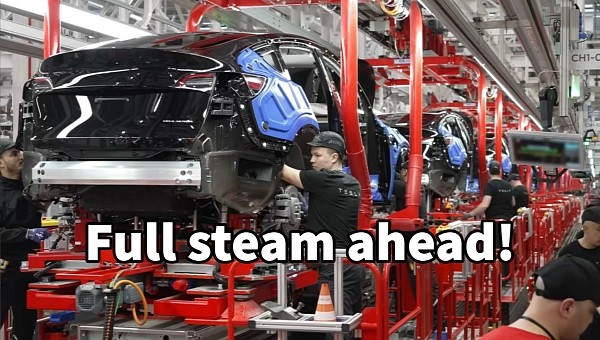Things are accelerating quickly at Giga Berlin as Tesla blasts through production milestones at a fast pace. The plant operates with three shifts currently, and a fourth shift is considered to expand the production capacity to the planned 500,000 units per year.
Tesla wanted to make a powerful statement by building its first European gigafactory in Germany. Economically, choosing a lower-income country in Eastern Europe would've made more sense. Still, Elon Musk decided to troll the powerful German auto industry and maybe poach its talents. The establishment fought back with all its might, and we wouldn't be surprised if the German auto industry financed the environmental groups that protested against Giga Berlin.
Thankfully, the drama appears to finally be over, and Tesla is ramping up production in Gruenheide even faster than it does in Austin. Giga Berlin has reached the mass-production phase, normally considered when production surpasses 5,000 cars per week. Tesla operates the factory with three shifts, as confirmed to rbb24 by Jochem Freyer, the head of an employment agency in Frankfurt that Tesla hired to fill positions at Giga Berlin.
Around 10,000 people currently work in Gruenheide, with most positions for the third shift already occupied. Freyer says that his agency only hires very specialized workers at the moment, but this would change as Tesla is poised to add a fourth production shift soon. With four shifts, Giga Berlin can reach the planned production capacity of 500,000 cars per year, translating into 10,000 vehicles per week. This is double the 5,000-unit milestone announced in March and completes the first production phase at Giga Berlin.
Tesla has already filed the necessary documentation to move Giga Berlin into phase two, doubling the production capacity to one million units per year. A document submitted to the Brandenburg State Office for Environment shows Tesla should be able to do that without needing more water resources. The American EV maker has perfected its water-saving and recycling skills to use very little water per vehicle produced. This should keep environmentalists happy while ensuring authorities that the Giga Berlin expansion would not affect local communities.
Tesla is expected to subsequently expand Giga Berlin's production capacity to reach up to two million vehicles. If rumors are true, the EV maker would also bring the next-gen EV production to Germany. Again, this wouldn't make much sense economically, as Tesla's compact car would need to be more affordable. Relatively high wages in Gruenheide would not allow Tesla to go as low as it would want to go with the next-gen vehicle's price.
There's a reason Tesla wants to start its production in Mexico, where the high-skilled workforce is cheaper. An Eastern European country would probably be more suitable for building the high-volume compact EV at affordable prices.
Thankfully, the drama appears to finally be over, and Tesla is ramping up production in Gruenheide even faster than it does in Austin. Giga Berlin has reached the mass-production phase, normally considered when production surpasses 5,000 cars per week. Tesla operates the factory with three shifts, as confirmed to rbb24 by Jochem Freyer, the head of an employment agency in Frankfurt that Tesla hired to fill positions at Giga Berlin.
Around 10,000 people currently work in Gruenheide, with most positions for the third shift already occupied. Freyer says that his agency only hires very specialized workers at the moment, but this would change as Tesla is poised to add a fourth production shift soon. With four shifts, Giga Berlin can reach the planned production capacity of 500,000 cars per year, translating into 10,000 vehicles per week. This is double the 5,000-unit milestone announced in March and completes the first production phase at Giga Berlin.
Tesla has already filed the necessary documentation to move Giga Berlin into phase two, doubling the production capacity to one million units per year. A document submitted to the Brandenburg State Office for Environment shows Tesla should be able to do that without needing more water resources. The American EV maker has perfected its water-saving and recycling skills to use very little water per vehicle produced. This should keep environmentalists happy while ensuring authorities that the Giga Berlin expansion would not affect local communities.
Tesla is expected to subsequently expand Giga Berlin's production capacity to reach up to two million vehicles. If rumors are true, the EV maker would also bring the next-gen EV production to Germany. Again, this wouldn't make much sense economically, as Tesla's compact car would need to be more affordable. Relatively high wages in Gruenheide would not allow Tesla to go as low as it would want to go with the next-gen vehicle's price.
There's a reason Tesla wants to start its production in Mexico, where the high-skilled workforce is cheaper. An Eastern European country would probably be more suitable for building the high-volume compact EV at affordable prices.











